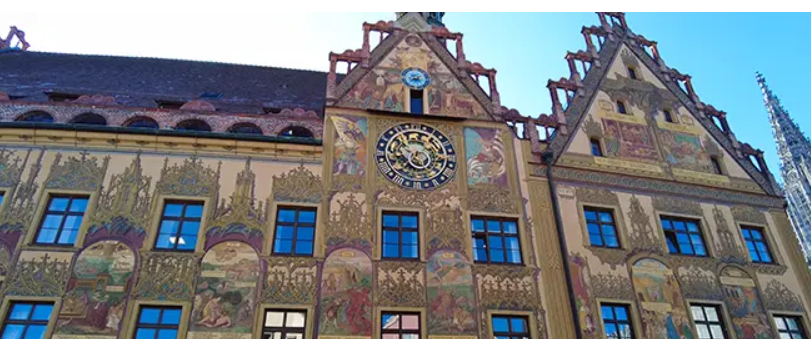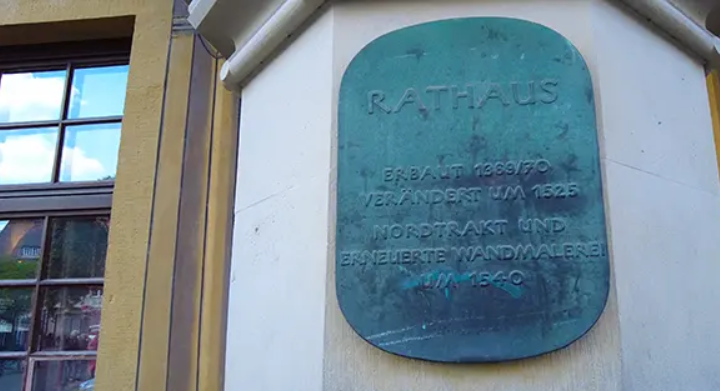Historic murals and an impressive astronomical clock
Address: Ulm Town Hall, Markplatz 1, 89073 Ulm | Built: 1357 | Architectural style: Early Renaissance
Anyone embarking on a stroll through Ulm will inevitably come across a special building that immediately catches their attention. It is the Ulm Town Hall, with its distinctive murals on the exterior facade and its astronomical clock, making this historic monument a unique attraction. Three different construction phases fit together like a mosaic. Construction began in the 14th century. Today, it is primarily the architecture of the Early Renaissance that characterizes the Ulm Town Hall in a special way.
Directions and Location of Ulm’s Landmark
The historic town hall is centrally located directly on the market square and is hard to miss when strolling through Ulm. The area around the building is bordered by Vestgasse and Kronengasse, towards the market square. The city library is located in the immediate vicinity, with its pyramid-shaped, glass architecture providing an impressive contrast to the town hall with its murals on its facade.
There are cafés, restaurants, and commercial buildings in the immediate vicinity. When it comes to the interplay of historic buildings and modern architecture, Ulm residents demonstrate courage. Not far away are the buildings of the New Center, which compete with each other with their clean, glass facades.
The historic town hall is located in a car-free zone, accessible only to delivery vehicles. This is very practical, as it means that visitors to Ulm don’t have to pay attention to traffic while admiring the beauty of the building.
Opening Hours and Tours
The historic Ulm Town Hall is still the seat of the government. Ulm visitors are therefore only allowed access to the entrance hall and the atrium. The tour ends there. A look inside is only possible during the following times:
Ulm Town Hall Opening Hours
Monday to Thursday:
8:00 a.m. – 6:00 p.m.
Friday:
8:00 a.m. – 2:00 p.m.

Ulm Town Hall Admission Prices
Because Ulm Town Hall is located on a publicly accessible square, it can be viewed from the outside at any time without paying an admission fee.
Guided Tours of Ulm Town Hall
Ulm Town Hall itself does not offer guided tours on site.
FAQ – Frequently Asked Questions about Ulm Town Hall
When was Ulm Town Hall built?
Ulm Town Hall was originally built in 1357 and initially served as a merchant’s and department store. As a central hub in the city center, it was not only geographically but also economically important and contributed to the city’s growth.
How old is the astronomical clock at Ulm Town Hall?
The astronomical clock at Ulm Town Hall is almost 500 years old. Completed in 1581, it is one of the oldest surviving astronomical clocks of its kind.
Ulm Town Hall – Special Features and Interesting Facts
The first thing that catches your eye are, of course, the unique facade paintings on Ulm Town Hall. But there are other special features on and inside the building. One of the most notable features on the exterior facade is the astronomical clock, which was installed on the facade as early as 1520.
Hardly anyone can read this astronomical clock correctly. This is due to the fact that it has five movable elements of different shapes. The clock’s hands depict the moon, the sun, an outstretched index finger, and a dragon.
Only a few details are depicted on the clock face. You can see the various signs of the zodiac, large Roman numerals, and small Arabic numerals. The clock has a total of 14 functions. Only those who study it extensively can understand how this clock works.
Those who go to the first floor of the historic town hall can admire a model of the astronomical clock, which actually works properly. It was built by an apprentice at the Philipp Hörz tower clock factory in Ulm.
If you take a closer look at the windows of Ulm’s town hall, you’ll discover another special clock in one of the council windows. This is a glass sundial, which allows you to tell the hours in the morning. This made it possible to tell the time during the Reichstag era when the Ulm council met in the morning. However, this was problematic if the council meeting lasted longer.
If you enter Ulm’s town hall and let your gaze wander, you’ll quickly discover a curiosity. The stairwell is decorated with a flying machine from a bygone era. It is not the original flying machine of the legendary “Tailor of Ulm” Albert Ludwig Berblinger, but merely a replica. He used the original to attempt his flight in front of a large audience on May 31, 1811, and crashed into the Danube.

Historical Facts and History of Ulm Town Hall
Admiring a historic building and immersing yourself in the city’s history is especially possible at Ulm Town Hall. The Gothic-style building has a lot to tell, dating back to the 14th century. Much has happened since then.
The southeastern part of the current building is the main building. It was built in 1370 and was considered a new merchant’s store or cloth hall. The name “Town Hall” was first used in 1419. Framed windows were installed on the east and south sides of the council chamber during the 15th century. These were decorated with sculptures of the six electors, which can still be found there today.
As far as the eye can see, the facade of the building is covered with murals. The paintings on the north and east sides of the building are likely by Martin Schaffner, a German woodcarver and painter who probably belonged to the Ulm School. This term encompasses several artists of the late Gothic and early Renaissance periods whose sphere of influence was in Ulm.
The building’s murals depict motifs such as “Justice,” “Divine Wisdom,” and “Self-Knowledge.” The north side primarily deals with biblical themes such as vices, virtues, and commandments. There are images from the Greek and Roman world of legend. The murals depicted, for example, “Obedience,” “Man’s Courage,” and “Warlike Honesty.”
Other sides are adorned with paintings depicting the “Ulm Box” and coats of arms of the cities and countries with which Ulm traded. They also depict the defense against the siege by Emperor Charles VI.
The original murals were largely destroyed by the weather at the time. The current images, which can be admired and discovered at Ulm Town Hall, date from 1900 and were restored and recreated according to the original models.

Sights and attractions in the immediate vicinity of Ulm Town Hall
An exploration tour of Ulm takes visitors almost directly from the town hall into winding, narrow alleys. They wind their way past truly ancient half-timbered houses dating back to times long past. Discover the so-called Grabenhäuschen (Grab Houses), built in 1610 along the Henkersgraben (Henker’s Ditch) and the city wall. They served as soldiers’ quarters during wartime. Their task was to defend Ulm against attacks by foreign troops. Today, 35 colorful houses can be admired, lined up in rows.
A stone’s throw from Ulm Town Hall is the Ulm Museum and the Weishaupt Art Gallery, which is certainly worth a visit for fans of modern art. The works on display in the art gallery come from the private collection of Siegfried Weishaupt. In front of the art gallery stands Keith Haring’s sculpture “Red Dog for Landois,” a feast for the eyes for modern art lovers. The Ulm Museum combines the art of architecture with ancient and modern art, archaeological finds, and displays a wealth of information on the city’s history. It also regularly hosts special exhibitions. Visitors are guided through the museum’s various levels, exploring paintings and art objects.
Cafés and Restaurants Near Ulm Town Hall
A sightseeing tour makes you thirsty and hungry, so everyone will appreciate a selection of coffee specialties, a piece of cake, a thirst quencher, or a filling meal. The murals on the Town Hall facade also provide plenty of material for stimulating conversation. Those who don’t want to use the Town Hall’s restaurant, which has a large outdoor terrace, will find lovely cafés and restaurants in the immediate vicinity that invite you to linger and enjoy. There’s guaranteed to be something for every taste!
The Museum Café-Bar, Market Square, is located in the immediate vicinity of Ulm Town Hall. Delicious coffees and delicious dishes are served in a wonderful atmosphere. You can also enjoy a hearty breakfast here before starting your sightseeing tour.
Address: Museum Café-Bar & Market Square 9
Coffee Fellows on Neue Straße offers its guests coffee specialties along with delicious breakfast creations or tasty bagels, which can be topped with your own toppings. When the weather’s nice, you can sit comfortably outside, watch the hustle and bustle, and admire the nearby buildings.
Address: Coffee Fellows, Neue Straße 85
La Fontana is located directly next to Ulm’s town hall on the market square. The menu offers Italian delicacies such as pizza and pasta. Culinary delights such as pumpkin salad or saltimbocca alla Romana are also prepared in the kitchen. Enjoy these delicious dishes with a view of Ulm’s town hall and its unique murals.
Address: La Fontana, Marktplatz 1
John Benton
If you’re craving a steak, John Benton on the market square is the place to be. Guests can enjoy grilled meat specialties and a variety of side dishes. The extended opening hours mean that hunger can be satisfied even late in the evening.
Address: John Benton, Marktplatz 16
Himalaya
Those more in the mood for Indian cuisine will find a fine selection at Himalaya, located right on the market square. Vegan dishes are also available, with no meat at all, and vegetarians will also find something to their liking. From a window seat, you can enjoy views of Ulm’s town hall.
Address: Himalaya, Market Square 5